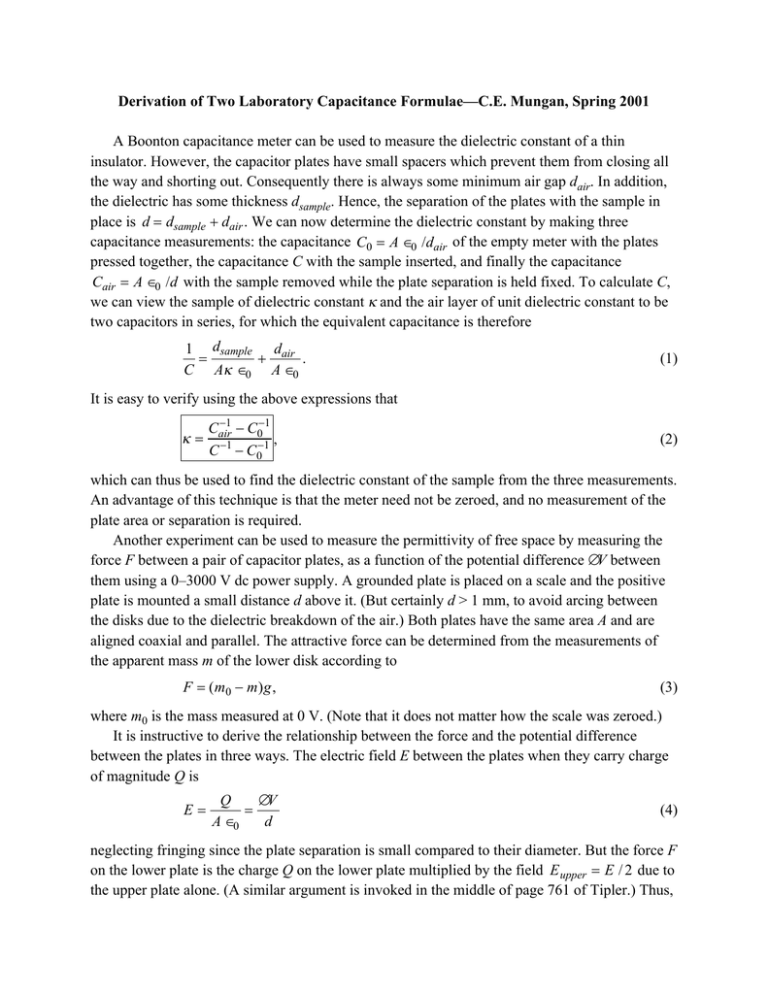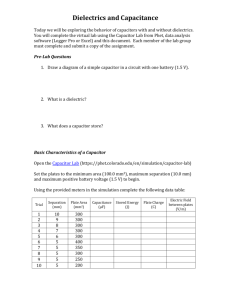Derivation of Two Laboratory Capacitance Formulae—C.E. Mungan, Spring 2001
advertisement

Derivation of Two Laboratory Capacitance Formulae—C.E. Mungan, Spring 2001 A Boonton capacitance meter can be used to measure the dielectric constant of a thin insulator. However, the capacitor plates have small spacers which prevent them from closing all the way and shorting out. Consequently there is always some minimum air gap dair. In addition, the dielectric has some thickness dsample. Hence, the separation of the plates with the sample in place is d = dsample + dair . We can now determine the dielectric constant by making three capacitance measurements: the capacitance C0 = A ∈0 /dair of the empty meter with the plates pressed together, the capacitance C with the sample inserted, and finally the capacitance Cair = A ∈0 /d with the sample removed while the plate separation is held fixed. To calculate C, we can view the sample of dielectric constant κ and the air layer of unit dielectric constant to be two capacitors in series, for which the equivalent capacitance is therefore 1 dsample dair = + . C Aκ ∈0 A ∈0 (1) It is easy to verify using the above expressions that κ= −1 − C0−1 Cair , C −1 − C0−1 (2) which can thus be used to find the dielectric constant of the sample from the three measurements. An advantage of this technique is that the meter need not be zeroed, and no measurement of the plate area or separation is required. Another experiment can be used to measure the permittivity of free space by measuring the force F between a pair of capacitor plates, as a function of the potential difference ∆V between them using a 0–3000 V dc power supply. A grounded plate is placed on a scale and the positive plate is mounted a small distance d above it. (But certainly d > 1 mm, to avoid arcing between the disks due to the dielectric breakdown of the air.) Both plates have the same area A and are aligned coaxial and parallel. The attractive force can be determined from the measurements of the apparent mass m of the lower disk according to F = ( m0 − m) g , (3) where m0 is the mass measured at 0 V. (Note that it does not matter how the scale was zeroed.) It is instructive to derive the relationship between the force and the potential difference between the plates in three ways. The electric field E between the plates when they carry charge of magnitude Q is E= Q ∆V = A ∈0 d (4) neglecting fringing since the plate separation is small compared to their diameter. But the force F on the lower plate is the charge Q on the lower plate multiplied by the field E upper = E / 2 due to the upper plate alone. (A similar argument is invoked in the middle of page 761 of Tipler.) Thus, 1 1 A ∈0 ∆V ∆V F = QE = 2 2 d d (5) where Eq. (4) was invoked twice in the second step. A second derivation is to calculate the amount of work W required to pull the plates apart from zero separation at which the plates have the same potential and hence zero potential energy to their final gap distance d for which the potential difference is ∆V and the potential energy is U, W = Fd = U = 12 C ( ∆V ) 2 . (6) The first equality follows from the fact that F in Eq. (5) is a constant, because E in Eq. (4) in turn is constant, for a fixed plate charge Q. Since C = A ∈0 /d is the final capacitance, Eq. (6) can be rearranged to give the same solution for F as Eq. (5). Finally, rather than changing the gap separation at constant plate charge Q, we can instead charge up the plates while they are separated by a fixed distance d. Imagine that at some arbitrary point in this process, the plate charge magnitude is q with a corresponding electric field E q = q / A ∈0 between the disks. The force required to move a small additional amount of charge dq from the negative to the positive plate against this electric field is dF = E q dq . Integrating from zero charge to the final charge Q gives Q F= ∫ 0 Q2 q . dq = A ∈0 2 A ∈0 (7) Relating Q to ∆V via Eq. (4) gives the same final solution once again, F= ∈0 A ( ∆V ) 2 . 2d 2 The slope of a plot of F versus (∆V)2 can thus be used to experimentally determine the permittivity of free space, ∈0 , assuming that the area and separation of the plates are known. (8)





